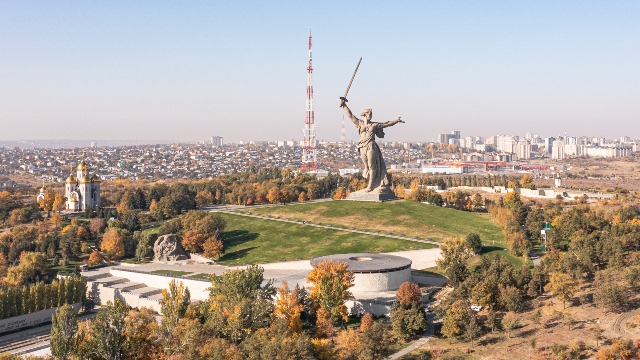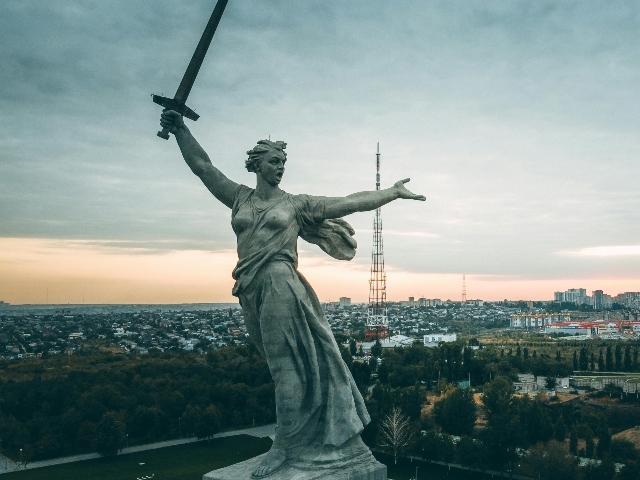
-
The Motherland Calls! Russia’s Massive Monument That’s Twice As Large As The Statue Of Liberty
22 Oct 2024 by Heinrich in russia, Tech/Sci
[imagesource:pexels]
One of the very few things Russia has in common with the United States is its fondness for enormous construction projects, and one of the best examples must be their The Motherland Calls! statue.
The Motherland Calls! is a 53-metre-tall statue of a woman raising a sword (85 metres if you include the sword itself) located in Volgograd – formerly known as Stalingrad.
Volgograd was the site of one of the longest, biggest, and most important battles of the Second World War, and as its self-explanatory name suggests, the female figure of The Motherland Calls! symbolises Mother Russia, calling on her citizens to join the war effort and follow her to victory.
When it was finished in 1967, it was the highest statue on the planet—a distinction that has since been overtaken by a series of progressively bigger religious and political statues across East Asia.
The Motherland Calls! was designed by Yevgeny Viktorovich Vuchetich, a sculptor from Ukraine. He was a key player in Soviet realism, an artistic style that favoured more realistic and metaphorical depictions of Soviet goals. Vuchetich was also a five-time recipient of the Stalin Prize and built countless monuments honouring Soviet heroes.
[image:wikimedia]
As one can imagine, the scale of The Motherland Calls! – which is twice as tall as New York’s Statue of Liberty and 40 times as heavy – made for a laborious construction process.
It required more than 5,5000 tons of concrete and 2,500 metric tons of metal, which had to be assembled with the help of an army of structural engineers. Any structure of this size threatens to collapse under its own weight, and the statue’s elegant pose – stepping forward, arms widespread and raised – made this threat even greater.
Valentina Izotova, a 26-year-old waitress, was chosen by Vuchetich to be the model for the sculpture, while the face of the statue is believed to have been based on that of Vuchetich’s wife.
Dit bericht op Instagram bekijkenThere are several reasons why the statue had to be so enormous. For one, its size is intended to signify the ‘magnitude of sacrifices’ the Russian people were required to endure during the war, but perhaps a more accurate explanation involves geopolitics. After all, the monument was erected during the Cold War, when the USSR competed with the US in almost everything from sending people into space to erecting the world’s tallest skyscrapers.
Over time, the statue has been renovated on several occasions, with one of the first taking place in the early 1970s, when engineers reinforced the statue’s sword to prevent it from swaying in the wind and potentially breaking off.
The most recent restoration began in 2019 after a report showed that the statue’s foundation was sliding away as it had been built on top of a riverbed.
In 2014, the sculpture, along with the surrounding complex, was listed as a tentative candidate for UNESCO’s list of World Heritage Sites.
[source:artnet]
Latest News
-
Powerful South African Short Film ‘The Last Ranger’ Scoops Up Awards And International Praise
[imagesource: Cindy Lee Director/Facebook] A compelling South African short film, The L...
-
Caprice Summer Has Started With Brunch (But Better) This Saturday + Other Lush Camps Bay Parties
[imagesource: Instagram/cafecaprice] Is it just me or has Summer been taking its sweet ...
-
Notre-Dame Cathedral In Paris Restored And Ready For Grand Reopening After Devastating Fire
[imagesource:wikimedia] After five years of work and millions in donations, The Notre-D...
-
Self-Destructing Number Plates: The Future Of Gauteng’s Roads Or Spy-Tech Fantasy?
[imagesource:worldlicenseplates.com] What sounds like a James Bond movie is becoming a ...
-
I Changed My Relationship With Food And You Won’t Believe What Happened Next
[imagesource:supplied] As the festive season approaches, it's time to deck the halls, g...
-






























